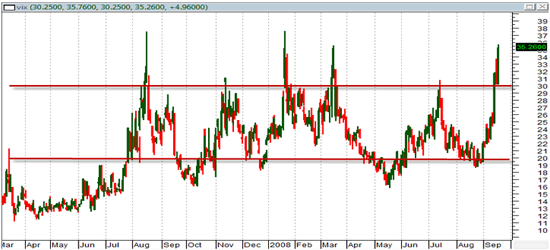Implied volatility, in the simplest sense, is the forward looking estimate of a security priceís volatility. For the most part, traders have always looked at volatility as one of the indicators; however, options implied volatility has become an asset class on its own due the role it plays in determining the option price. Option Pricing The price of an option is basically derived from two main factors: its intrinsic and time value. Intrinsic value refers to the optionís inherent or equity value. For example, if you hold a $30 call option on a stock thatís trading at $45; you can buy the stock at $30 strike price and sell it to the market at $45. Thus, the intrinsic value of the option is $15 ($45-$30=$15). Only the stockís price and the optionís strike price would have an influence on the optionís intrinsic value. Time value, on the other hand, is determined by a host of different factors, such as the interest rates, stock and strike price, time until expiration, and the optionís implied volatility. Of all these factors, none is more significant than implied volatility. Supply and demand for a specific option influences its implied volatility; thus, as the optionís implied volatility increases, so will its premium price. The rise and fall of an optionís time value is hugely dependent on its implied volatility. Get the Basics Down Pat It is important to translate all this information in a trading sense. Thatís why when you are charting and analyzing implied volatility, it is wise to take note of these two considerations: ē Implied Volatility Moves in Cycles Implied volatility fluctuates pretty much like stock prices. Keeping this options trading basic in mind will help you devise a good entry and exit strategy. The optionís high volatility period is most likely followed by a reversion to the mean or low volatility periods. Thus, determining the relative highs, mean, and relative lows in your chart will give you an idea when to enter a trade where you stand to gain maximum profits or where you can minimize your risk.  ē Implied Volatility are Always Analyzed Relatively Analyzing volatility values varies for different equities. What may be considered as high implied volatility for one equity may be considered low for another. For example, what may be considered as high volatility value for Intel Corporation (INTC) may be considered low for Apple (AAPL) since Appleís volatility range is way higher than INTCís. How to Use Options Implied Volatility in Trading To profit from this information, you need to select an appropriate trading strategy based on your ability to forecast an optionís implied volatility. Here are important things to consider: ē Keep the Basics in Mind Itís always wise to have your trading decisions firmly footed on the fundamentals. That means you need to be a master in determining whether the implied volatility is relatively high, low, rising, or falling. Remember that a high percentage of implied volatility means that the option premium price is high and vice versa. In addition, you need to determine the level at which the option premiums become overvalued and undervalued based on its relative implied volatility. ē Thereís Always a Reason Behind High Options Implied Volatility When thereís a sudden spike in implied volatility, it is wise to keep in mind that thereís almost always a reason for this Ė and itís always in your best interest to know whatís causing the spike so you make a wise trading decision. For example, a spike could be caused with the usual tradersí frenzy following an earnings report, merger rumor or announcement, product approval, etc. Know that news events that donít have much bearing to a companyís long-term outlook will most likely cause fleeting effect on its implied volatility. Keep this in mind and be prudent when you see sudden spikes; most optionsí implied volatility would implode after a sudden high and it would revert back to its mean. You wouldnít want to get caught in that. ē Apply Trading BasicsóBuy Low; Sell High One significant use of option implied volatility is that it tells you which trading strategy to employ. For example, if you see options with relatively high percentage of implied volatility, itís the best opportunity to put to use selling strategy since you can reasonably anticipate a reversal. Some strategies you might consider in this instance include: short straddles, naked put, and covered calls. In the same way, if you see options trading with relatively low implied volatility, use a buy strategy, such as long straddles, buying calls, and debit spreads. The cheap premium gives you the best position to profit when it rises again. Options implied volatility might come off as a complex concept to understand; however, once you wrap your mind around the concept really well, itís actually a very simple, yet significant indicator that helps you make better trading decisions. This alone could help you not get involved in market hype and keep your wits about you. But as with everything in trading, thereís a learning curve to this concept Ė but itís worth making that journey.
|

|
|
|
|